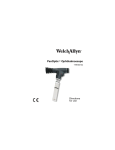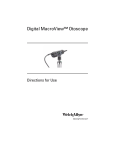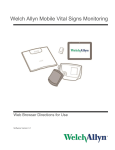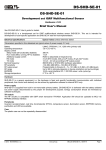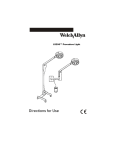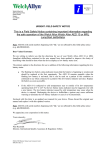Download Mark-up of 5th version of AED10 Technical Note
Transcript
Technical Note Battery Management Best Practices Welch Allyn AED 10™ Background Welch Allyn introduced the AED 10 (previously branded MRL Jumpstart) automated external defibrillator in December 2002. The device employs a single non-rechargeable, Lithium (LiMnO2) battery pack which is specified to provide approximately five years of standby performance. Depending upon environmental conditions, patterns of use, and age, AED 10 batteries will eventually begin to indicate a low battery condition, but this can occur at varying times. For example, activities such as power on or extended idle operation of devices, when performed frequently, will shorten an otherwise longer timeframe before the AED 10 indicates “Low Battery.” Welch Allyn takes this opportunity to re-emphasize various important points described in the AED 10 User Manual regarding battery management, including advising users to inspect/verify the device battery status using scheduled inspections and to employ battery management best practices to ensure readiness. Verifying Readiness To ensure the readiness of your AED 10, it is important to respond immediately to low battery status indicators regardless of when they occur. In addition to the self-test performed by the device, the AED 10 should be inspected weekly or monthly, depending on the frequency of its use. An operator’s checklist, found in the Welch Allyn AED 10 User Manual, should be maintained according to the schedule outlined below. Frequency of Use Monthly Infrequent (e.g., once a year) Inspection Schedule Weekly Monthly Check battery readiness by verifying that the AED 10 status indicator, located left of the device green power button, is in a “ready to use” state (solid black icon). If the status indicator is flashing a red circle with a slash through it, this indicates a “Low Battery” situation. A low battery condition does not render the unit nonfunctional but does indicate that the battery is beginning to weaken. Continue to use the AED 10 if needed but replace the battery at the first opportunity. If a solid “red circle with slash” symbol appears, turn on the AED 10 and note the self-test results. If the unit has powered on and a “Self-Test Failure” is indicated, remove the AED 10 from service and contact Welch Allyn technical service immediately. If AED 10 will not power on, replace the battery as it may be drained. Attempt to, once again, power on the AED 10. If the AED 10 successfully powered on and a “Self-Test Failure” is indicated, or if the AED 10 will still not power on, remove the AED 10 from service and contact Welch Allyn technical support immediately. 2008 April Technical Note Length of Use of Battery Length of use of the battery before a “Low Battery” indication is dependant on proper power management. Several variables can affect duration of battery performance. The most common contributors to shorter timeframes are: • Frequent device power ups to check the status of the device. As provided in the User Manual, battery capacity is diminished with every activation or “power up” of the device. Remember the device performs automatic self-tests on a weekly and monthly basis; therefore additional power ups are not required. • Harsh use or storage conditions, e.g., hot or cold environments, <0C or >50C for use or storage, or near the specified operating limits as provided in the User Manual. Battery capacity may also be diminished by other environmental extremes such as humidity >95%, moisture IPX4 and altitude <-150 to >4750 m. Best Practices To ensure readiness and lengthen use of an AED 10 battery before a low battery indication, we recommend the following as provided in the User Manual: • Rely solely on the device’s status indicator to identify the operational readiness of the device rather than powering up the device. Only attempt to power up the device after a solid red circle with a slash appears in the battery indicator as described under “Verifying Readiness” above. Solid Black = Ready, Flashing Red Circle = Low Battery, Solid Red Circle = Do Not Use. • Always check the status indicator after each use and replace the battery at the first opportunity if low. A low battery condition does not render the unit non-functional but indicates that the battery is beginning to weaken. • Always have a fully charged battery (backup) available for use • Always replace the battery every five (5) years due to degradation of battery chemistry • Perform regular maintenance checks of your device to ensure it is ready when needed. o Establish periodic inspections of your device on a weekly or monthly basis depending on frequency of use (see above) o An Operator’s Checklist is also provided in the manual for your convenience Full Information Full information on battery maintenance and installation is available in the AED 10 User Manual. For any service-related issues, please contact your local Welch Allyn authorized service center. A list of Welch Allyn offices worldwide is available on our website: www.welchallyn.com. 2008 April


